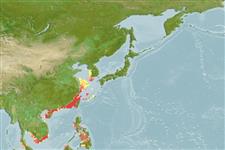Common names from other countries
>
Clupeiformes (Herrings) >
Dorosomatidae (Gizzard shads and sardinellas)
Etymology: Clupanodon: Latin, clupea = sardine, derived from Clupeus = shield; doubtless a reference to the scales covering the body of the fish (Ref. 45335).
More on author: Linnaeus.
Environment: milieu / climate zone / depth range / distribution range
Ecologia
marinhas; Água doce; estuarina; anádromo (Ref. 51243); intervalo de profundidade 0 - 50 m (Ref. 188). Tropical; 41°N - 6°N, 98°E - 128°E (Ref. 188)
Northwest Pacific: China, apparently south to Viet Nam (Philippine records of Fowler appear doubtful). Eastern Indian Ocean: Specimens were recorded from Phuket Island, Thailand (Andaman Sea).
Tamanho / Peso / Idade
Maturity: Lm ? range ? - ? cm
Max length : 26.0 cm SL macho/indeterminado; (Ref. 188)
Espinhos dorsais (total) : 0; Espinhos anais: 0; Raios anais : 22 - 28. Body moderately deep; belly with 16 to 19 (usually 18) + 9 to 12 (usually 10 or 11) total 27 to 31 (usually 29 or 30) scutes; pre-dorsal scutes present, 17 to 26 (usually 20 to 25). gill rakers of first arch at least 3/4 length of gill filaments. Vertebrae 43 to 46 (usually 44 or 45). A dark spot behind gill opening, followed by further spots on flank.
Found in coastal waters and in rivers, presumably tolerating brackish water, if not fully fresh condition. More data needed.
Ciclo de vida ou comportamento de acasalamento
Maturities | Reprodução | Spawnings | Egg(s) | Fecundities | Larvas
Whitehead, P.J.P., 1985. FAO Species Catalogue. Vol. 7. Clupeoid fishes of the world (suborder Clupeoidei). An annotated and illustrated catalogue of the herrings, sardines, pilchards, sprats, shads, anchovies and wolf-herrings. FAO Fish. Synop. 125(7/1):1-303. Rome: FAO. (Ref. 188)
Status na Lista Vermelha da UICN (Ref. 130435)
CITES (Ref. 128078)
Not Evaluated
Ameaça para os humanos
Reports of ciguatera poisoning (Ref. 4690)
Uso pelos humanos
Pescarias: espécies comerciais
Ferramentas
Relatórios especiais
Baixar XML
Fontes da internet
Estimates based on models
Preferred temperature (Ref.
115969): 24 - 29, mean 27.4 (based on 184 cells).
Índice de diversidade filogenética (Ref.
82804): PD
50 = 1.0000 [Uniqueness, from 0.5 = low to 2.0 = high].
Bayesian length-weight: a=0.00933 (0.00531 - 0.01641), b=3.07 (2.92 - 3.22), in cm Total Length, based on LWR estimates for this species & (Sub)family-body (Ref.
93245).
Nível Trófico (Ref.
69278): 3.1 ±0.3 se; based on size and trophs of closest relatives
Resiliência (Ref.
120179): Elevada, tempo mínimo de duplicação da população menor que 15 meses (Assuming tm=1).
Prior r = 1.19, 95% CL = 0.79 - 1.79, Based on 1 data-limited stock assessment.
Fishing Vulnerability (Ref.
59153): Low to moderate vulnerability (27 of 100).
Climate Vulnerability (Ref.
125649): Very high vulnerability (78 of 100).
